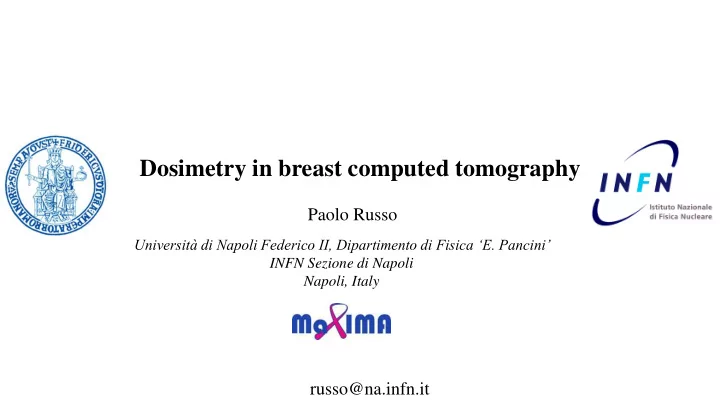

Dosimetry in breast computed tomography Paolo Russo Università di Napoli Federico II, Dipartimento di Fisica ‘E. Pancini’ INFN Sezione di Napoli Napoli, Italy russo@na.infn.it
Phase-contrast breast microCT w/ SPECT University of Rochester (Prof. R. Ning) ( University of Naples «Federico II» ) Koning Corp. commercial scanner 60-120 kV (FDA/EU approved for diagnostic imaging University of California Davis (Prof. J. M. Boone) 80 kVp in combination with mammography, non contrast) 49 kVp University of Massachusetts University of Erlangen & CT Imagi ng (Prof. W. (Prof. A. Karellas) 70 kVp A. Kalender) Photon-counting detector 60 kVp 2
Dosimetry in dedicated breast CT MGD = Mean Glandular Dose (mGy) DgN CT = Normalized glandular dose coefficient in CT (mGy/mGy) K = Air kerma at scanner isocenter (mGy) in a full rotation MGD = DgN CT × K MAMMOGRAPHY: Mean Glandular Dose MGD = DgN x ESAK 3
Breast model and irradiation geometry Homogeneous mixture adipose+glandular Energy range: 4.25 – 82.25 keV 4
Skin thickness influence on MGD - Cylindrical breast - Breast height = 1, 1.5, 2*breast radius - Homogeneous adipose/glandular mix - Skin thickness = 1.45 mm 5
Photon and electron interactions DgN w/o bremsstrahlung /DgN w/bremsstrahlung Breast diameter = 14 cm Simulated processes: 1.01 Glandular fraction = 20% - Compton Scatter - Rayleigh Scatter - Photoelectric effect 1.00 - Bremsstrahlung 0.99 20 40 60 80 Incident photon energy (keV) 6
Monoenergetic and Polyenergetic DgN CT Homogeneous mixture adipose+glandular 1.0 Monochromatic DgN 0.8 DgN (mGy/mGy) 0.55 Polyenergetic DgN Glandular fraction: 0.6 0.50 0% DgN (mGy/mGy) 25% 0.4 50% 0.45 75% 100% Breast diameter = 12 cm 0.40 0.2 Glandular fraction = 25% 0.35 0.0 10 20 30 40 50 60 0.30 Incident photon energy (keV) 49 kVp HVL = 1.29 mm Al 0.25 𝐹 𝑛𝑏𝑦 𝛸(𝐹) × ϑ(𝐹) × DgN(𝐹) × ∆𝐹 𝐹 𝑛𝑗𝑜 6 8 10 12 14 16 18 pDgN CT = 𝐹 𝑛𝑏𝑦 𝛸(𝐹) × ϑ(𝐹) × ∆𝐹 Breast diameter (cm) 𝐹 𝑛𝑗𝑜 7
Interpolated data for monoenergetic DgN CT Homogeneous mixture adipose+glandular 1.0 Breast height= Radius x 2 Radius x 1.5 0.8 Radius x 1 DgN CT 0.6 2 > 0.9999 Fitting R 0.4 Breast diameter = 120 mm Breast glandularity = 25% 0.2 Calculated values 8th-order polynomlial fit-curve 0.0 10 20 30 40 50 60 70 80 Primary photon energy (keV) 8
Patient specific breast phantoms 9
Simple model vs patient specific breast phantoms A case study In this specific case the MGD calculated with the homogeneous cylindrical model is 21% lower than the one calculated with the patient specific phantom (49 kVp; W/Al) 10
DgN CT coefficients assessment 20 segmented 3D images * of 20 different breasts Mean Std Min Max Glandular 28.0 22.6 4.9 76.0 fraction (%) Diameter 11.2 2.1 6.4 14.6 (cm) * by courtesy of Prof. Ioannis Sechopoulos - Radboud UMC – Nijmegen (NL) 11
Glandular dose distribution within a patient specific heterogeneous breast (left) and within a homogeneous cylindrical breast model (right). The grey lines indicate the skin boundary. The coronal slice was selected at 2.1mm from the chest wall and the sagittal slice is at the mid- breast. Simulated beam quality: 49 kVp, HVL=1.40mm Al. 12
DgN CT coefficients assessment 1.4 HVL = 1.29 mm Al Mean = 1.04 Max Hom. cont./Real breast model 49 kVp Std. Dev. = 0.13 1.2 Min = 0.80 th percentile 90 th percentile 75 Median Max = 1.36 Mean 1.0 th percentile 25 th percentile 10 0.8 Min DgN Mean = 1.08 Std. Dev. = 0.10 Min = 0.85 Max = 1.27 13
Conclusions - Homogeneous and heterogeneous breast models for MGD evaluation in breast CT have been presented, with 1.45 mm skin thickness - Monoenergetic and polyenergetic DgN coefficients have been provided up to 80 keV with Geant4 MC simulations - MGD estimates differ by less than 8%, on average, with respect to a patient specific breast model (min -15%, max +27% difference) (49 kVp, HVL 1.4 mmAl) russo@na.infn.it 14
Recommend
More recommend